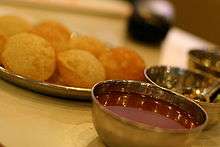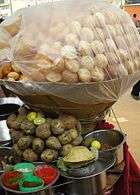Panipuri
 | |
| Type | Snack |
|---|---|
| Place of origin | India |
| Region or state | East India |
| Main ingredients | Flour, spiced water, onions, potatoes, chickpeas |
|
| |
Panipuri (![]() pānīpūrī ) is a common street snack in several regions of the Indian subcontinent. In East India, it is misidentified with Phuchhka which is very different from Panipuri.
pānīpūrī ) is a common street snack in several regions of the Indian subcontinent. In East India, it is misidentified with Phuchhka which is very different from Panipuri.
The Puchhka (also called so in Bangladesh) differs greatly in terms of content and taste. Puchkas use a mixture of boiled gram and mashed potatoes as the filling[1] and is tangy rather than sweetish while the water is sour and spicy. Puchkas are also slightly bigger in size and the puris are darker in colour. In North India, it is called Golgappa, In madhaya pradesh It is called Fulki, In Andhra Pradesh and Telangana its is called as Pani Puri While in Odisha it is known as GupChup . It consists of a round, hollow puri, fried crisp and filled with a mixture of flavored water (commonly known as Imli Pani), tamarind chutney, chili, chaat masala, potato, onion and chickpeas.[2]
History
Panipuri literally means "water bread". Little is known about its origins. The term pani puri was recorded in 1955;[3] and golgappa in 1951.[4]
Gallery
 Golgappa or panipuri van for vending in many parts of India.
Golgappa or panipuri van for vending in many parts of India. Homemade panipuri.
Homemade panipuri.- Potato stuffing.
 Panipuri stall.
Panipuri stall.- Panipuri arranged in a stall.
- Cream panipuri.
Names
Panipuri has various names, depending on the region.
In Haryana it is called Paani ke Patashe; in Madhya Pradesh Fulki; in Uttar Pradesh Golgappa, in West Bengal, Bangladesh and Bihar Nepal, Puchka; in parts of Gujarat, Pakodi; in parts of Odisha, South Jharkhand, Chhattisgarh,Gup Chup.[5] in Andhra Pradesh and Telangana it is called Pani Puri.
In popular culture
There was a monthly children's magazine published in 1970 in Delhi, called Golgappa.[6] Panipuri was used in the movie Rab Ne Bana Di Jodi starring Sharukh Khan and Anushka Sharma, in which they had the "Golgappa eating challenge". In the film, the person who eats the most Golgappas is the winner and can ask the loser to do anything he or she wishes.[7]Since it is a popular snack, companies such as Haldirams now offer Panipuri kits as part of their product range across India and abroad.[8]
See also
References
- ↑ "11 Different Names For Your Favourite Pani Puri". indiatimes.com. Retrieved 2017-06-12.
- ↑ Ramprasad, Gayathri (2014). Shadows in the Sun: Healing from Depression and Finding the Light Within. Hazelden. p. 260. ISBN 978-1-61649-531-2.
- ↑ "Some visitors are impressed with the unique foods of the city, famous among them are Aalu Chap (a hot potato preparation), Golgappa (a juicy preparation)..", The National Geographical Journal of India, page 116, published by National Geographical Society of India, 1955.
- ↑ Census of India, 1951, 8:1:474.
- ↑ "11 Different Names For Your Favourite Pani Puri".
- ↑ Published from M- Pratap Ganj, 475, Lahori Gate, Delhi, Timeless Fellowship - Page 110 by Karnatak University Library Science Association, Library Science Association, Karnatak University School of Library Science, School of Library Science, Karnatak University - Library science – 1978.
- ↑ "Rab Ne Bana Di Jodi". 12 December 2008 – via IMDb.
- ↑ "Pani Puri". Haldiram's. Retrieved 2017-02-02.



